Your cozy outdoor area holds untapped potential to become a cherished extension of your home. As landscape expert Lisa Port notes, even postage-stamp yards can bloom into vibrant retreats when approached thoughtfully. The secret lies in treating limited square footage not as a hurdle, but as a chance to craft intimate environments where every detail shines.
Design challenges like balancing privacy with openness become creative opportunities in skilled hands. Susan Morrison, renowned for transforming urban spaces, emphasizes that strategic planning often yields more satisfying results than sprawling layouts. Through smart zoning and multi-functional elements, you can carve out distinct areas for dining, relaxation, and greenery without overcrowding.
Many gardeners initially struggle with issues like inadequate planting space or predictable sightlines. By learning from common small-space gardening mistakes, you’ll discover how vertical gardens boost capacity while trellises add dimension. Container arrangements that adapt with the seasons keep your layout fresh and engaging.
The payoff goes beyond aesthetics. A well-designed compact yard enhances your home’s curb appeal while creating personal sanctuaries that feel larger than their measurements. With clever plant choices and space-smart solutions, your outdoor oasis becomes a testament to the power of intentional design.
Understanding Your Small Garden’s Potential
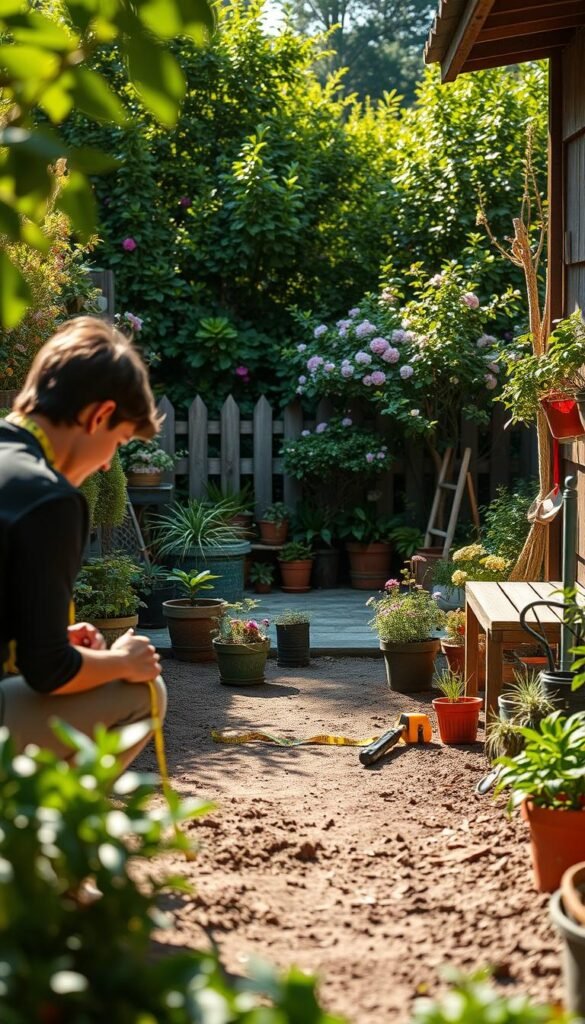
Transforming a limited outdoor space into a lush retreat starts by understanding its unique features. Landscape designer Susan Morrison suggests asking three vital questions: “What activities matter most?”, “When will you use the yard?”, and “Who shares this space?”. These answers shape smart layouts that feel spacious rather than cramped.
Assessing Your Available Space
Grab a tape measure and sketchpad first. Note not just ground dimensions but also:
- Vertical surfaces like fences or walls
- Sun patterns across different garden areas
- Existing trees or structures affecting airflow
Lisa Port’s 25-foot-deep front yard project proves even narrow sites can flourish. Track how light shifts daily—that sunny morning corner might host herbs, while shaded afternoon zones suit ferns.
Identifying Key Usage Areas
Prioritize functions that match your lifestyle. Do you crave morning coffee nooks? Evening gathering spots? Designate zones using:
- Movable planters instead of permanent beds
- Multi-level seating that doubles as storage
- Visual cues like pavers or lighting
Observe natural pathways through your yard—align walkways with these routes to maintain flow. Remember, a compact garden space can multitask: a dining table might become a potting bench by afternoon.
Tips for Small Garden Design: Maximizing Limited Space for Maximum Impact
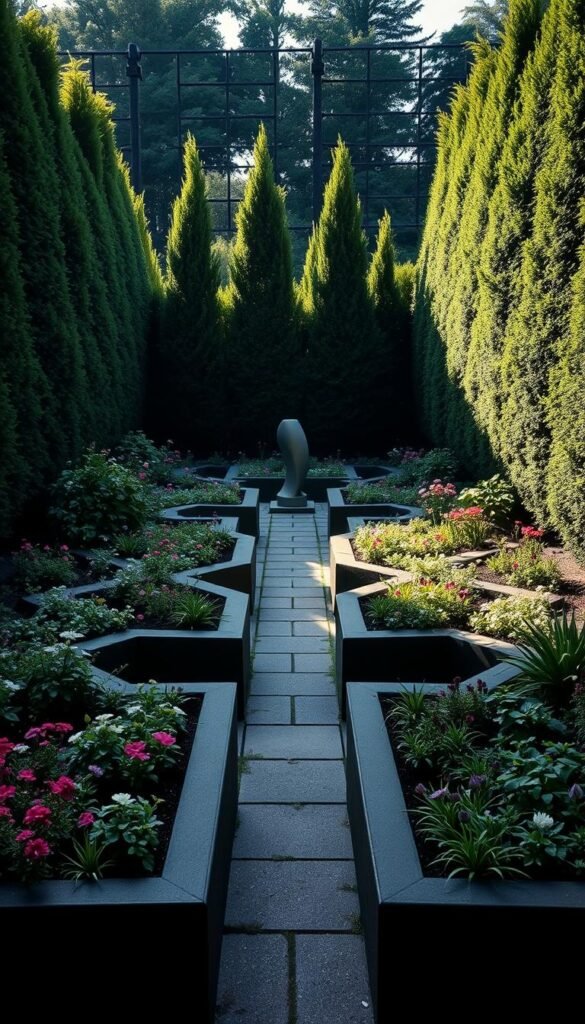
Angular layouts transform spatial limits into creative assets. Landscape designer Lisa Port’s geometric approach uses zigzag paths and triangular planters to trick the eye. “Sharp angles create natural pauses,” she notes, “giving each area room to breathe while maintaining flow.”
Build depth through layered arrangements. Place columnar evergreens near boundaries, then mid-height shrubs, with creeping thyme at ground level. This tiered setup makes your garden feel deeper than its actual size. Contrast textures like spiky yucca against rounded boxwoods for added drama.
Stick to a tight color scheme with one dominant hue and two accents. A crimson Japanese maple becomes a focal point when surrounded by silver-toned Artemisia. Extend visual boundaries by aligning sightlines with distant trees or architectural features beyond your fence line.
| Design Element | Purpose | Example |
|---|---|---|
| Angular Layouts | Create visual journey | Z-shaped stepping stones |
| Layered Planting | Add depth perception | Tall grasses behind hydrangeas |
| Cohesive Themes | Prevent visual chaos | All-white bloom selections |
| Strategic Color Use | Direct attention | Yellow chair in green corner |
Incorporate seasonal stars like winterberry holly for cold-month color. Tuck a miniature water feature behind ferns to reward curious explorers. These intentional choices help your small space punch above its weight class year-round.
Strategic Plant Selection for Compact Gardens
Smart plant choices turn tight spaces into lush retreats. Landscape designer Lisa Port proves this with her signature color-blocking technique: “A limited palette creates cohesion, while contrasting textures add depth.” Her project pairing gold hinoki cypress with red bee balm shows how bold foliage and strategic color choices energize confined areas.
Size-Smart Flora for Lasting Appeal
Dwarf varieties like ‘Tequila Sunrise’ kangaroo paw deliver big impact without crowding your garden. These space-efficient stars bloom for months and stand just 18 inches tall. Susan Morrison advises: “Choose performers like catmint that work overtime—their lavender spikes charm from spring through fall.”
Prioritize plants serving multiple roles. Sweet flag grass offers vertical interest and thrives in wet planting zones. Combine it with mound-forming sedums that suppress weeds. This layered approach maximizes every square foot while reducing maintenance.
Color Strategies That Expand Horizons
Lisa Port’s bright green and chartreuse scheme demonstrates how color manipulates perception. Light-reflecting hues make dark fences recede, creating an airy feel. For year-round drama, mix evergreen shrubs with vibrant container arrangements that change seasonally.
Remember: contrasting leaf shapes add visual spice when flowers fade. Pair spiky yucca with rounded heuchera leaves. This textural play keeps your small garden engaging even in winter months. Smart plant partnerships ensure your limited space always feels abundant.
Mastering Vertical Gardening and Space Utilization
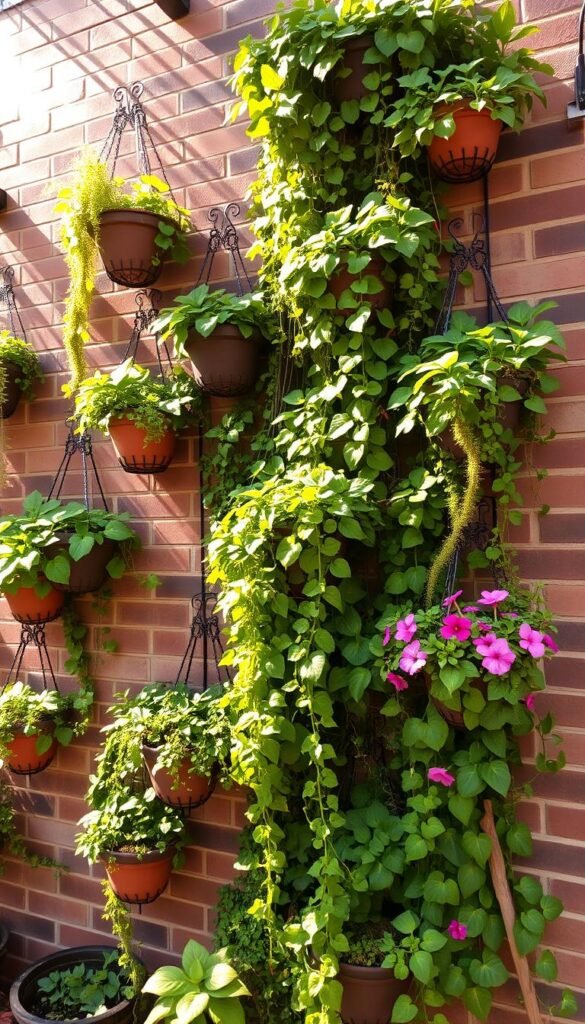
Reaching upward unlocks new dimensions in cozy outdoor areas. “Vertical layers add depth while keeping pathways clear,” notes designer Lisa Port, who once transformed a 6-foot-wide balcony using stacked planters. This approach turns blank walls and fences into thriving ecosystems that engage the eye at multiple levels.
Implementing Trellises and Hanging Planters
Port’s bamboo container towers demonstrate how height creates illusions of spaciousness. Train climbing roses on metal grids or let sweet peas cascade from hanging baskets. Susan Morrison suggests: “Mount succulent frames near seating areas—they’re living art that needs minimal soil.”
| Vertical Element | Best Use | Plant Partners |
|---|---|---|
| Wall Planters | Herb gardens | Thyme, oregano |
| Trellis Systems | Privacy screens | Clematis, jasmine |
| Hanging Baskets | Visual layers | Fuchsias, trailing lobelia |
Container Gardening and Raised Beds
Angular ceramic pots add modern flair while maximizing space efficiency. Terracotta containers prevent root rot in moisture-loving plants like ferns. Build raised beds with built-in benches—they define garden zones while offering hidden storage.
Port’s experimental cedar pyramid planters prove containers can be both functional and sculptural. For vegetable gardening, use self-watering boxes on railings. These solutions let you curate micro-environments where each specimen shines.
Incorporating Hardscape and Focal Points in Small Gardens
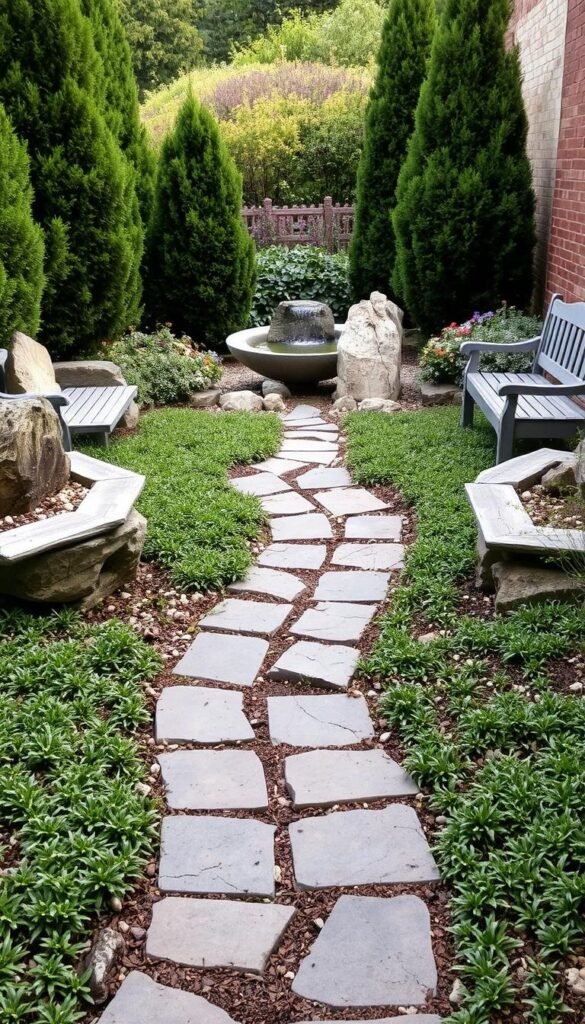
Thoughtful arrangements of stone and greenery can transform even the most compact outdoor areas into captivating retreats. Landscape designer Lisa Port demonstrates this with her discreet gate concept: “A seamless entryway maintains privacy without shouting ‘look at me’. Her fence-blending gates create gentle transitions from street to sanctuary, while strategic focal points guide visitors through the space.
Crafting Pathways That Tell Stories
Narrow walkways of irregular flagstone invite exploration while maximizing planting areas. Susan Morrison recommends using materials like crushed granite between stepping stones—it’s budget-friendly and lets rainwater seep through. Curved paths around raised beds create natural pauses, making your garden feel more expansive.
Position key features where they serve multiple purposes. A rustic bench doubles as a planter divider, while a curated collection of potted succulents elevates plain walls into living art. Morrison’s three-tiered approach to focal elements works wonders:
| Focal Point Type | Placement | Example |
|---|---|---|
| Destination Features | Middle to rear areas | Sculpture under birch tree |
| Unifying Elements | Between activity zones | Jar fountain with trickling water |
| Detail Accents | Visible from indoors | Ornamental grasses by window |
Scale your patio to human proportions—a 6×8-foot area comfortably fits two chairs and side table. Paint fences in muted greens to recede visually, then train clematis along sections for texture. Every design choice should whisper “welcome” while maintaining your private oasis vibe.
Creating a Low-Maintenance Garden Plan
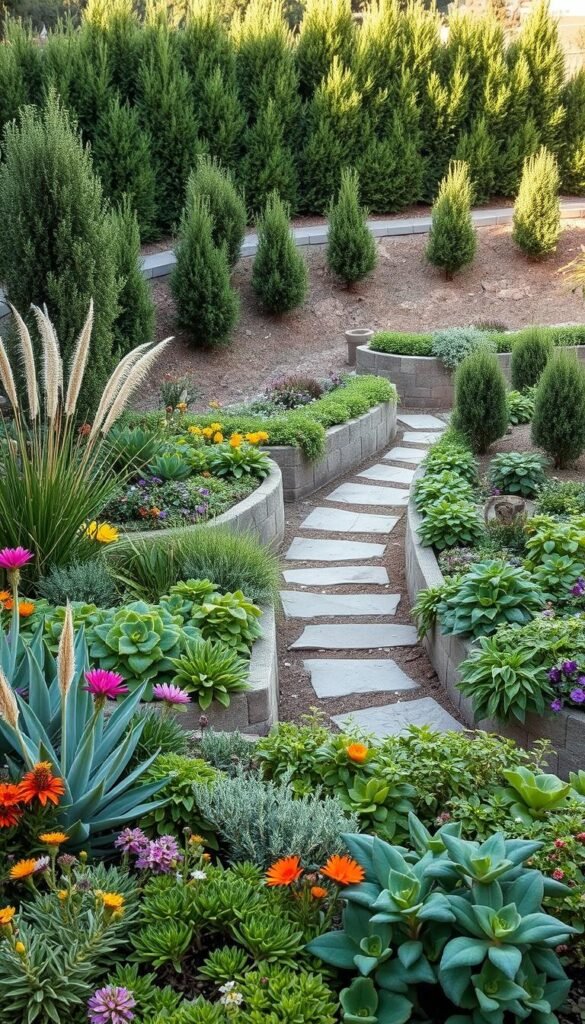
Crafting an efficient outdoor space begins with smart habits that let your garden thrive with minimal effort. As Susan Morrison observes, “Native species act like old friends—they already know how to flourish in your environment.” This philosophy reduces maintenance while boosting plant resilience, letting you enjoy rather than constantly tend your green retreat.
Developing a Smart Watering and Fertilizing Routine
Your plants will tell you when they’re thirsty—if you know how to listen. Push your finger two inches into the soil before reaching for the hose. When you do water, make it count: deep weekly sessions train roots to grow downward, creating drought-resistant specimens. Pair this with a season-al schedule—prune spring bloomers after flowering, fertilize summer growers in June.
Choose organic, slow-release fertilizers that feed plants gradually. Morrison warns against overfeeding: “Think of fertilizer as vitamins, not meals—too much creates weak growth.” Apply these nutrients during active growing periods, then let nature take over.
Simplify care with strategic mulching. A 3-inch layer of bark chips keeps soil moist and weeds scarce. Group moisture-loving plants near rain barrels or drip lines, while drought-tolerant varieties occupy drier areas. This zoning cuts time spent dragging hoses across your garden.
Your plan should make upkeep effortless. Install accessible paths between beds and position self-watering containers near seating zones. With these intentional choices, you’ll spend less time working and more moments savoring your thriving oasis.
Designing Multifunctional Areas for Relaxation and Entertainment
Your outdoor space becomes a stage for life’s best moments when designed with intention. Landscape pro Susan Morrison shows how compact areas can host Sunday brunches and quiet reading sessions equally well. Her secret? Zoning strategies that make 100 square feet feel like multiple destinations.
Smart Layouts for Outdoor Living
Position lounge chairs to frame your garden’s showstopper plants while hiding compost bins or AC units. Morrison’s “ladies who lunch” patio concept uses neighboring trees for natural shade—no bulky umbrellas needed. Foldable furniture like stackable bistro chairs or expandable tables keeps your space adaptable for crowds or solo coffee breaks.
Create intimate outdoor rooms using vertical screens of bamboo or climbing roses. Lisa Port’s clients love their sun-soaked nook shielded from street views by strategic planter boxes. Add all-weather curtains to pergolas for instant privacy or shelter during surprise showers.
Boost functionality with built-in benches that hide garden tools and LED string lights for evening ambiance. Your patio can moonlight as a workspace by day when you pair a weatherproof table with comfy cushions. Every inch earns its keep when you blend beauty with clever utility.






